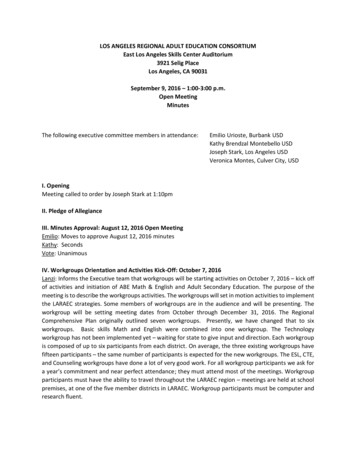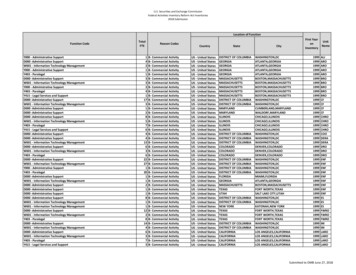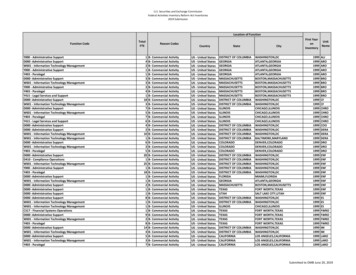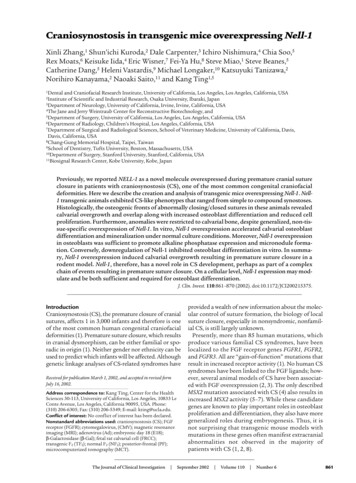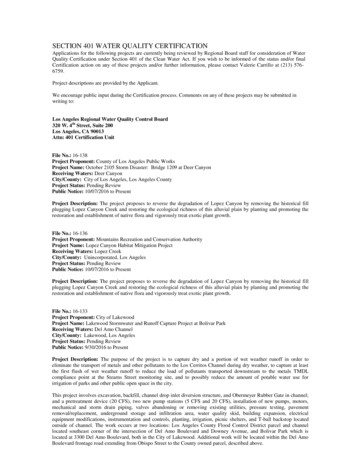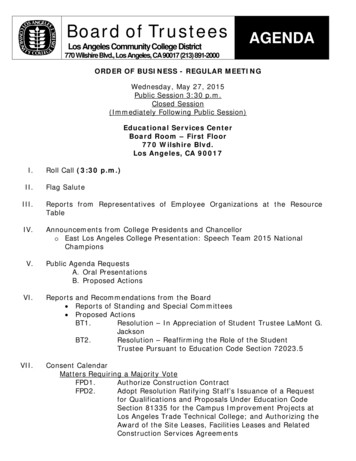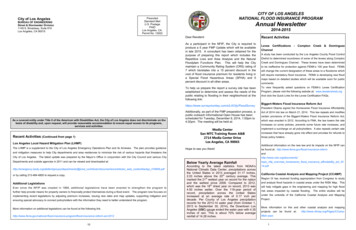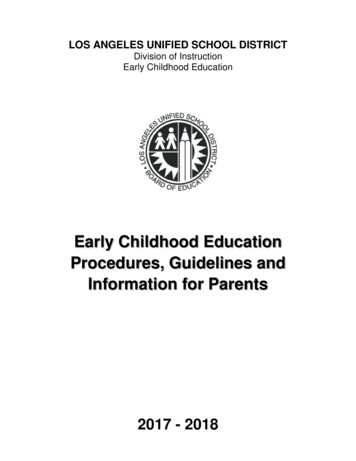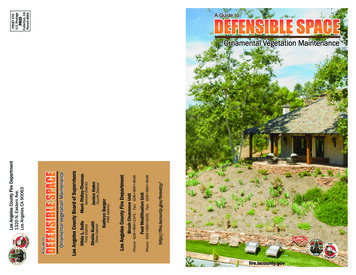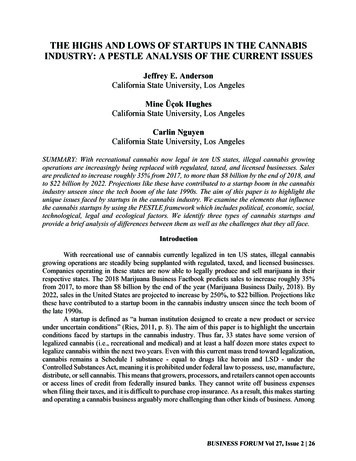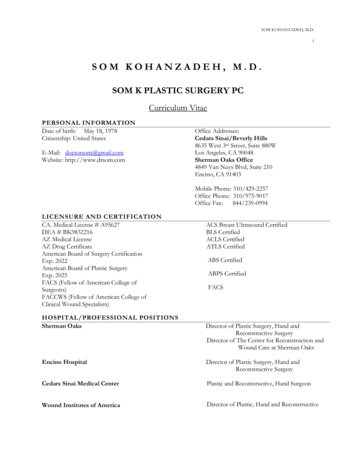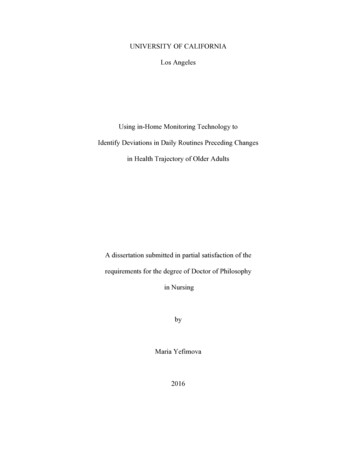
Transcription
UNIVERSITY OF CALIFORNIALos AngelesUsing in-Home Monitoring Technology toIdentify Deviations in Daily Routines Preceding Changesin Health Trajectory of Older AdultsA dissertation submitted in partial satisfaction of therequirements for the degree of Doctor of Philosophyin NursingbyMaria Yefimova2016
Copyright byMaria Yefimova2016
ABSTRACT OF THE DISSERTATIONUsing in-Home Monitoring Technology toIdentify Deviations in Daily Routines Preceding Changesin Health Trajectory of Older AdultsbyMaria YefimovaDoctor of Philosophy in NursingUniversity of California, Los Angeles, 2012Professor Janet C. Mentes, ChairThe boom of in-home monitoring technology offers unprecedented information about anindividual’s interaction with the environment. A variety of low cost sensors can continuously andunobtrusively collect information about activities in the living space. Capturing early changes inthe daily routines of vulnerable older adults residing in these “smart homes” may allow cliniciansto predict and prevent negative health consequences through timely intervention. However, thecurrent state of science is hampered by the lack of theoretically driven approaches to analyzesensor data in relation to clinically meaningful health outcomes. The aims of the study are 1) tocharacterize an older adult’s daily routine, as captured with smart home sensors, 2) to assess ifdeviations from it are indicative of changes in their health trajectory, such as falls, ER visits orunplanned hospitalizations, and 3) identify between person factors that affect the characteristicsii
of the daily routine. It used previously collected data from 10 residents of TigerPlace, a uniqueretirement facility that evaluates health technology affiliated with University of Missouri,Columbia. Older adults live in apartments equipped with network of motion, depth and bedsensors that unobtrusively collect information about daily activity of its resident. Thirty monthsof continuous sensor data were analyzed in the context of bi-annual clinical assessments andnursing notes extracted from the electronic health record. A retrospective multiple case studyapproach is guided by the conceptual model developed for this study that is grounded in nursingand gerontological literature. Changes in the temporality and frequency of daily activity werefound for common geriatric symptoms, such as urinary symptoms and confusion. Seasonal andweekly effect was evident across participants in the duration of time spent in various areas of theapartment. Participants varied in their baseline daily routines, but for the majority of symptomsthere were prodromal changes in at home activity that was detected with sensors. As the cost oftechnology adoption decreases, nurses can use these innovative tools to coordinate care andintervene early to prevent or mitigate the functional decline associated with vulnerable olderadults.iii
The dissertation of Maria Yefimova is approved.Diana Lynn WoodsBetty L. ChangWendie A. RobbinsJanet C. Mentes, ChairUniversity of California, Los Angeles2016iv
DEDICATIONTo my supporter, critic, and interdisciplinary collaborator —my future husband, Mark Gottscho.To my role model in innovative nursing entrepreneurship —my mother, Julia Yefimov.To all older adults living fervently, independently, and alone —among them, my grandmother, Tatyana Ivanovna Rumyantseva.v
TABLE OF CONTENTSABSTRACT OF THE DISSERTATION . iiCommittee Page . ivDedication Page . vTABLE OF CONTENTS . viLIST OF TABLES . viiiLIST OF FIGURES . ixACKNOWLEDGMENTS . xBIOGRAPHICAL SKETCH . xiiINTRODUCTION TO DISSERTATION . 1Using Technology for Health Monitoring of Older Adults . 2Identified Gap . 4Study Overview . 5Significance . 6Organization of Chapters . 6REFERENCES . 8CHAPTER 1 . 13Trajectories of Daily Routines in Older Adults: A Model for Monitoring with Technology. 13Abstract . 13Introduction . 14Background . 16Theory Development . 20Proposed Model . 25Implications . 29Conclusion . 29TABLES . 31FIGURES . 32REFERENCES . 35CHAPTER 2 . 43A Case Study of In-Home Monitoring Technology Reveals Health-Related Changes inDaily Routines of Older Adults. 43Abstract . 43Introduction . 44Background . 46Research Aims . 48Methods . 49Results . 54Discussion . 60Conclusion . 63vi
TABLES . 64FIGURES . 68REFERENCES . 72CHAPTER 3 . 80Considerations for the Effective Smart Home Health Monitoring of Older Adults. 80Abstract . 80Introduction . 81Considerations . 83Conclusion . 98TABLES . 100FIGURES . 101REFERENCES . 103CONCLUSION TO DISSERTATION . 112vii
LIST OF TABLESChapter 1 - Table 1 . 31Phases in Chronic Illness Trajectory Framework and Their Management Schemas. 31Chapter 2 - Table 1 . 64Pertinent characteristics of participants and their living environments . 64Chapter 2 - Table 2 . 65Characteristics of Participants’ Health Trajectories . 65Chapter 2 - Table 3 . 66Individual Health Trajectory Phases . 66Chapter 2 - Table 4 . 67Relationship between daily routine feature trends and clinical context . 67Chapter 3 - Table 1 . 100Considerations for deployment of sensor systems for long-term health monitoring . 100viii
LIST OF FIGURESFigure 1. Relationships between meta-concepts from the four guiding theories (P – person; H –health, T – time, B – behavior) . 33Chapter 1-Figure 2. Trajectories of Daily Routines in Older Adults. . 34Figure 3. Sensor Network for a typical one-bedroom apartment and the corresponding areas fordaily routines. . 68Figure 4. Identifying a personal baseline using time maps and aggregate features of the dailyroutine. . 69Figure 5. Features of the daily routine for each participant shown both as the average andstandard deviation of duration and frequency of motion detected in various areas of theapartment, aggregated by 24 hours. . 70Figure 6. An example of triangulation and visual analysis of clinical and sensor data. . 71Figure 7. Sensor data coded into daily routine areas with little uncertainty and uncertainty due toconflicting sensor firings. 101Figure 8. Comparison of clinical and sensor data for an 88-year-old female for one calendaryear. . 102ix
ACKNOWLEDGMENTSThis dissertation was made possible with the generous support of John A. HartfordBuilding Academic Geriatric Nursing Capacity Scholarship, Sigma Theta Tau InternationalHonors Society Gamma Tau at Large Chapter Research Award, and the UCLA GraduateResearch Mentorship and Dissertation Year Fellowship Awards.Thank you to my dissertation committee members, Dr. Lynn Woods, Dr. Betty Changand Dr. Wendie Robbins and my dissertation chair, Dr. Janet Mentes, for guidance, feedback andsupport in the processes of preparing the dissertation.As an accelerated Bachelors-to-PhD student, I was apprehensive to embark on a nontraditional path of pursuing an academic career straight after completing my undergraduatenursing degree. However, at UCLA School of Nursing Center for Advancement ofGerontological Nursing Science (AGNS) I found the inspiration and support to follow my dreamof improving nursing care for older adults through research. I especially and deeply thank mylong-standing mentors, Dr. Woods and Dr. Mentes, as well as other AGNS faculty, Dr. MaryCadogan and Dr. Linda Phillips. They opened a window of opportunities that was only possibleat an outstanding, research-intensive institution, such as UCLA.I also want to thank my Hartford co-mentor, Dr. Marilyn Rantz at the University ofMissouri, Columbia, who shared her vision of aging-in-place with technology and allowed me touse TigerPlace data for secondary analysis. The Center for Eldercare and RehabilitationTechnology, led by Dr. Marjorie Skubic, is an example of an outstanding interdisciplinary team.Thank you to my then-student collaborators and now Drs. Tanvi Banerjee and ZahraHajihashemi who taught me the intricacies of working with sensor data and the publishingx
process in the technical field. Thank you to Akshay Jain for helping me create visualizations ofthe data. I hope we continue to collaborate!Thank you to my family, friends, and colleagues who continuously supported me throughthese five years and made this process less lonely and isolating. Thank you for keeping megrounded and reminding to get out of my academic bubble once in a while.Lastly, I cannot find words to express my gratitude to a particularly special person, whowas there every day of this journey, from before I even considered applying to the PhD program.He listened to my theoretical ponderings at 3am, taught me how to code in MATLAB (andreally, wrote most of the code himself), let me cry when my data did not make sense, recoveredmy files when I messed up the cloud sync, and brought me food when I was sitting in the libraryall day on Sundays – among so many other things. I cannot thank you enough, Mark Gottscho.Without you, this dissertation would not be.xi
BIOGRAPHICAL SKETCHEducation2013–2014 Graduate Certificate in Gerontology, University of Southern California2011–2014 Master of Science, Nursing, University of California, Los Angeles2007–2011 Bachelor of Science with Major in Nursing, University of California, Los AngelesPublicationsWoods, D.L. Yefimova, M. Kim, H., Phillips, L.R. (2016). “Detecting and CharacterizingPatterns of Behavioral Symptoms of Dementia” In M. Magnusson, J.K. Burgoon & M.Casarrubea (Eds.), Discovering Hidden Temporal Patterns in Behavior and Interaction:T-pattern Detection and Analysis with THEMETM (pp. 125-142). New York: Springer.Hajihashemi, Z., Yefimova, M. & Popescu, M. (2014). Detecting Daily Routines of Older AdultsUsing Sensor Time Series Clustering. IEEE Engineering in Medicine and Biology SocietyProceedings.Woods, D.L., Yefimova, M. & Brecht, M.L. (2014). A Method for Measuring Person-CenteredInterventions: Detecting and Characterizing Complex Behavioral Symptoms of Personswith Dementia, Clinical Gerontologist, 37, 2, 139-150.Yefimova, M. & Woods, D.L. (2012). Using Sensor Technology To Monitor DisruptiveBehavior in Persons with Dementia. 2012 AAAI Fall Symposium Series.Woods, D.L. & Yefimova, M. (2012). Evening Cortisol is Associated with IntraindividualInstability in Daytime Napping in Nursing Home Residents with Dementia: An AllostaticLoad Perspective. Biological Research for Nursing, 14, 4. 387-395.Woods, D.L., Kim, H. & Yefimova, M. (2011). Morning Cortisol is Associated with BehavioralSymptoms of Dementia. Biological Research for Nursing, 13, 196-203.Woods, D.L., Kim, H. & Yefimova, M. (2011). To Nap or not to Nap: Cortisol Diurnal Rhythmand Daytime Napping in Nursing Home Residents with Dementia, Biological Researchfor Nursing, 13, 185-190.PresentationsYefimova, M., Woods, D.L., Mentes, J.C., Rantz, M., Skubic, M. Big Data of Everyday Life:Considerations for the Evaluation of In-Home Monitoring Technology for Older Adults.68th Scientific Meeting of the Gerontological Society of America. Orlando, FL. November,2015. Podium Presentation.Yefimova, M., Jain, A., Woods, D.L. & Rantz, M.J. Monitoring Daily Routines of Older Adultswith In-Home Sensor Technology: A Case Study. 48th Western Institute of Nursingxii
Communicating Research Conference. Albuqurque, NM. April 22-25, 2014. PosterPresentation.Yefimova M., Beck P. & Woods, D.L. Adopting Health Information Technology in ResidentialCare Facilities: Care for the 21st Century. 34th California Council on Gerontology andGeriatrics Annual Meeting, Sacramento, California. April 4, 2014.Yefimova, M., Hajihashemi, Z., Banerjee, T., Woods, D.L., Popescu, M., Skubic, M., Rantz, M.& Keller, J. Characterizing Trajectories of Daily Routines of Older Adults with SensorTechnology. 47th Western Institute of Nursing Communicating Research Conference.Seattle, WA. April 10-12, 2014. Podium Presentation.Yefimova, M., Hajihashemi, Z., Banerjee, T., Woods, D.L., Popescu, M., Rantz, M.J., Skubic,M. & Keller, J.M. Daily Routines of Older Adults: A Novel Method of Measurement. 67thScientific Meeting of the Gerontological Society of America. Washington DC. November,2014. Poster Presentation.Yefimova, M. & Woods, DL. A Case Study of Interaction Leading to Escalation of Behavior.46th Annual Western Institute of Nursing Communicating Nursing Research Conference,Anaheim, California. April 12, 2013. Podium Presentation.Yefimova, M., Woods D.L. & Rantz, M.J. Using Smart Home Technology to Monitor Routinesof Older Adults. 13th National Hartford Centers for Gerontological Nursing ExcellenceLeadership Conference. New Orleans, LA. November, 2013. Poster Presentation.Yefimova, M. & Woods, DL. A Case for Using Sensor Technology to Monitor DisruptiveBehaviors of Persons with Dementia. 2012 AAAI Fall Symposium: AI forGerontechnology. Arlington, VA. November 3, 2012. Podium Presentation.Yefimova, M. & Woods, DL. Intra-individual Variability in Longitudinal Research on Aging.65nd Scientific Meeting of the Gerontological Society of America Conference. San Diego,CA. November, 2012. Podium Presentation.Honors and Awards2016-2017 Sigma Theta Tau International Honor Society, UCLA/CSUN Gamma Tau ChapterResearch Award2015-2016 UCLA Dissertation Year Fellowship2012-2014 National Hartford Centers for Gerontological Nursing Excellence Patricia G.Archbold Scholar Award (formerly John A. Hartford Pre-Doctoral Scholar Award)2012-2013 UCLA Graduate Research Mentorship Award2009-2010 Nurses Caring for Older Adults Young Scholar recognized by the Center forAdvancement of Gerontological Nursing Science at UCLA School of Nursingxiii
INTRODUCTION TO DISSERTATIONThe rapid growth of the aging population, the evolving role of nursing in healthcare, andthe ubiquitous proliferation of technology pose challenges and opportunities for the future. Thenumber of people over the age 65 will more than double, from 40.2 million in 2010 to 88.5million by 2050 (US Census Bureau, 2010). As more adults survive into the old age, manynavigate lives burdened by multiple chronic conditions and disability. Currently, more than 50%of people over the age of 65 have three or more chronic diseases (Anderson, 2010), which affectstheir ability to perform daily activities. Nevertheless, older adults want to maintain independencethrough optimal function and to “age-in-place” of their choosing (Vasunilashorn, Steinman,Liebig, & Pynoos, 2012). The need to support the growing numbers of older adults puts a strainon caregivers and long-term care services. Nurses can improve health of older adults throughchronic disease management, health promotion, education, and collaboration with otherdisciplines.The challenges following this demographic shift create a unique opportunity for nurses tospearhead the health system reform. Spurred by the Patient Protection and Affordable Care Actof 2010, new care delivery models emerge with the goal of containing cost and providing qualityoutcomes through care coordination (American Nurses Association, 2010). With older adultsbeing the primary users of healthcare resources accounting for 60% of total US healthcareexpenses (Centers for Disease Control and Prevention, 2013), the scope of practice makesnursing profession indispensable to the evolving healthcare organizations (American NursesAssociation, 2012). Nurses can improve health of older adults through chronic diseasemanagement, health promotion, education, and collaboration with other disciplines.1
The healthcare delivery system needs reorganizing to accommodate older adults agingwith multiple chronic illnesses. Instead of the current focus in primary care that emphasizesacute illness and symptom relief, Wagner (1994) proposes shifting towards a systematic ongoingassessment of functional ability, illness course and self-management strategies. These can beused to initiate preventative interventions, education, psychological support, and follow up inthose with chronic illness. Understanding the progression health and illness over time rather thanfocusing on episodes of care, such as hospitalizations, can inform clinicians about timely andappropriate interventions (Wyman & Henly, 2011). A continuous, rather than occasional,assessment of the individual’s needs and abilities would allow nurses to more effectively supportindependence and preserve function of the older adults.Rather than focusing on disease burden and disability, a more holistic approach may bemore insightful in understanding complex and fluctuating needs of older adults. Performance andparticipation in daily activities have been major indicators of function (Palmer & Harley, 2012)Existing measures evaluate impairment by proxy of how much help is needed in performingcertain everyday tasks, sometimes missing the pre-clinical stages of functional decline (Fieo,Austin, Starr, & Deary, 2011). On the other hand, the variety, level and duration of engagementin daily activities may be more sensitive markers of change. Monitoring temporal changes in thedaily routines of older adults may assist in understanding the overall trajectory of their health(Zisberg, Young, Schepp, & Zysberg, 2007).Using Technology for Health Monitoring of Older AdultsInterdisciplinary engagement with sciences outside the health field can further transformthe provision of care. Recent advances in electrical and computer engineering have alreadyrevolutionized everyday life but have been slowly integrated in the healthcare industry (Groves2
& Knott, 2013). Embedded systems, ranging from large computer systems to various specializedsensors and devices, can collect large amounts of information about the world. Ubiquitouscomputing and analysis of this “big data” have the potential to generate robust predictions basedon past patterns (Swan, 2012; Vimarlund & Wass, 2014). Information and communicationtechnology allows for global connectivity of both people and devices sharing information in the“Internet of Things” (Boyd & Crawford, 2011; Nitzsche, Thiele, Häber, & Winter, 2014). Thesetechnological capabilities can create powerful change when applied to the questions aboutnursing care for older adults.Tele-health and tele-medicine have already proven effective in monitoring vital signs andbasic physiological markers for certain chronic conditions, such as congestive heart failure andchronic obstructive pulmonary disease (Brettle, Brown, Hardiker, Radcliffe, & Smith, 2010;Wakefield et al., 2008). Behavior monitoring is an emerging expansion of this endeavor (Yang &Hsu, 2012). Low-cost and unobtrusive sensors can objectively collect data about person’sactivity throughout the day for months and years (Rantz, Skubic, & Miller, 2009; Yang & Hsu,2012). For people with multiple chronic conditions where symptoms are not clear, pronounced,monitoring behavior rather than physiological markers may be more robust for detecting healthchanges.Currently there are multiple attempts to breach the disciplines involved in “gerontechnology” and to create effective behavior monitoring technology (Dara-Abrams, 2008).Wearable and mobile sensors proliferate the market and research arena for physical activity, butthey have limitations with the older adult population (Bakkes, Morsch, Krose, & Kröse, 2011;Banaee, Ahmed, & Loutfi, 2013). Non-wearable sensors can be more effective because they areunobtrusive for long-term monitoring (Cutler, 2007; Kaye et al., 2011). “Smart homes” with3
networks of cheap and reliable sensors installed in various locations can monitor activity withoutany effort on the resident’s part (Reeder, Demiris, & Thompson, 2015; Thielke et al., 2012).There is a bursting interest in the development of ambient technologies for the aging population,but in the recent years the field of geron-technology stalled in the analysis and interpretation ofthe evaluation phase.Identified GapA number of research groups have attempted to employ environmental sensors fordetecting in-home activities of older adults (Hayes et al., 2008; Kaye et al., 2011; Rantz et al.,2013). Due to large volume and complexity of sensor data, the challenge has been in extractingmeaningful signals from the noise (Rashidi & Mihailidis, 2013). Much work has been done inthe fields of electrical engineering and computer science to develop novel activity recognitionalgorithms for these types of data (Noury et al., 2011). However, many of these statistical modelslack a solid theoretical foundation or clinical insight into human behavior and health. Oftentimes,it becomes an interesting computational challenge not validated with established clinicaloutcomes.Moreover, while some approaches have been successful in precisely controlled laboratorysettings with healthy (if old) test subjects, issues arise when these algorithms are applied tocomplex “real life” situations (Chan, Campo, Estève, & Fourniols, 2009; Wilson, Hargreaves, &Hauxwell-Baldwin, 2015). Implementing and evaluating technology with real subjects requirescollaboration among multiple stakeholders, including researchers, clinicians, family membersand older adults themselves. To move the field forward, there is a need for clinically driven andtheory-supported approaches to analyzing sensor data from real older adults.4
Study OverviewThis dissertation attempted to fill the gap by developing and applying a conceptual modelto explain the relationship between health and everyday behavior of older adults, captured within-home sensors. The proposition that changes in stability of daily routines signal symptomaticphases in the health trajectory was explored using retrospective descriptive multiple case studies.An ongoing multi-disciplinary project at the University of Missouri, Columbia (Rantz et al.,2005, 2008, 2010, 2014) provided secondary data from an in-home monitoring system alreadydeployed in apartments of its residents and the corresponding clinical assessments and healthrecords. It was analyzed for patterns of changes in day-to-day activity (measured byenvironmental sensors) through the years of health changes (measured by clinical assessmentsand medical records).The purpose of the study is to answer the research question: What changes in the dailyroutines of older adults, as measured by in-home monitoring technology, precede acute changesin their health trajectory?Definitions Health Trajectory is the course of temporal changes in illness, wellness and functioningthroughout the person’s life. A cute changes in health trajectory, such as an increase inphysical, cognitive or psychological symptoms or functional decline, can lead to
2016-2017 Sigma Theta Tau International Honor Society, UCLA/CSUN Gamma Tau Chapter Research Award 2015-2016 UCLA Dissertation Year Fellowship 2012-2014 National Hartford Centers for Gerontological Nursing Excellence Patricia G. Archbold Scholar Award (formerly John A. Hartford Pre-Doctoral Scholar Award)
